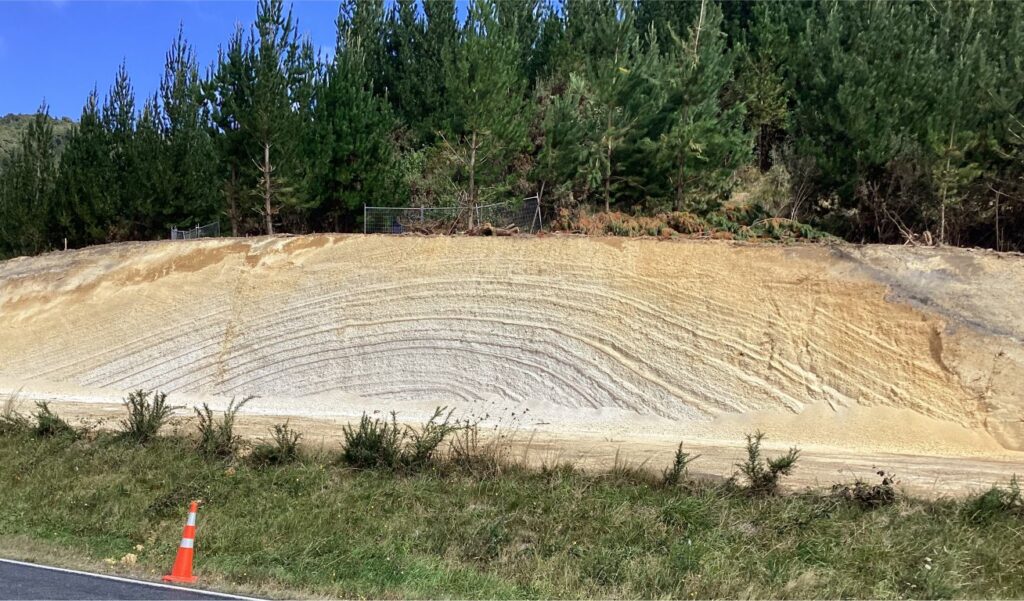
Every geological outcrop tells a story.
How often do you pass a road-side rock outcrop that grabs your attention, a glimpse out of the corner of your eye, but not wanting to drive into a ditch, you carry on. Worthy of a stop on the return journey, so grab a quick look at the odometer and notable landmarks. The road-cut in in this instance is a nice example of airfall pyroclastic deposits draping and modifying antecedent topography. It is only a single outcrop, but it has a story to tell.
The road-cut is about 2 km north of Tikitapu Lake (Blue Lake) and 6 km south of Rotorua (Aotearoa-New Zealand). It is located along the western margin the Okataina Volcanic Centre (OVC) that is the most recently active part of the Taupo Volcanic Zone. The OVC consists of several “nested collapse structures” comprising the Okataina caldera complex that formed during two main collapse events at 280 ka and 65 ka (Spinks at al., 2004, PDF). The youngest major eruptive event was the Tarawera eruption in 1886 that buried several villages in ash, killing 108 people and destroying the iconic Pink and White Terraces. A recent Open Access volume of the Journal of Volcanology and Geothermal Research (de Ronde et al., 2022, Editors) provides windows into recent OVC research.
Physical characteristics of airfall pyroclastic deposits
Airfall tephras are derived from four main types of eruption:
- Magmatic eruptions where fragmentation results from extremely rapid decompression of gas in rising magma. Pyroclasts consist almost entirely of juvenile material;
- Phreatic eruptions where rock heated by magma is in contact with groundwater or seawater, but does not involve new magma, and
- Phreatomagmatic eruptions, where rising magma is in contact with groundwater, crater lake water, or seawater – Surtsey (Iceland) is an iconic example.
- Airfall tephras can also evolve from pyroclastic density currents when ash and lapilli are elutriated from the top of fast-moving flows (also called co-ignimbrite fall tephras).
Explosive volcanic eruptions generate turbulent columns of fragmented magma and country rock, plus water vapour and gas, that punch through the air, frequently reaching many kilometres altitude. Most phreatic and phreatomagmatic eruptions produce explosive jets or pulses of short duration – each pulse has the potential to be deposited as a tephra bed. At some point in this violent ascent, frictional drag and gravity forces exceed the forward momentum and the solid material falls to Earth. The fall rate, or terminal velocity is determined primarily by grain size, grain shape, and density (e.g., Stokes Law), but in volcanic eruptions the adhesive effects of water vapour can strongly influence velocity values. Basically, this means that the big bits will land close to the vent. All these factors result in a degree of hydraulic sorting while airborne. The resulting tephra deposits represent a balance among the processes of accumulation, surface reworking, and erosion.
The common outcrop attributes of airfall deposits are summarized below, illustrated with a few examples:
- Airfall tephra deposits typically blanket local topography and any construction that presents a reasonably flat surface.
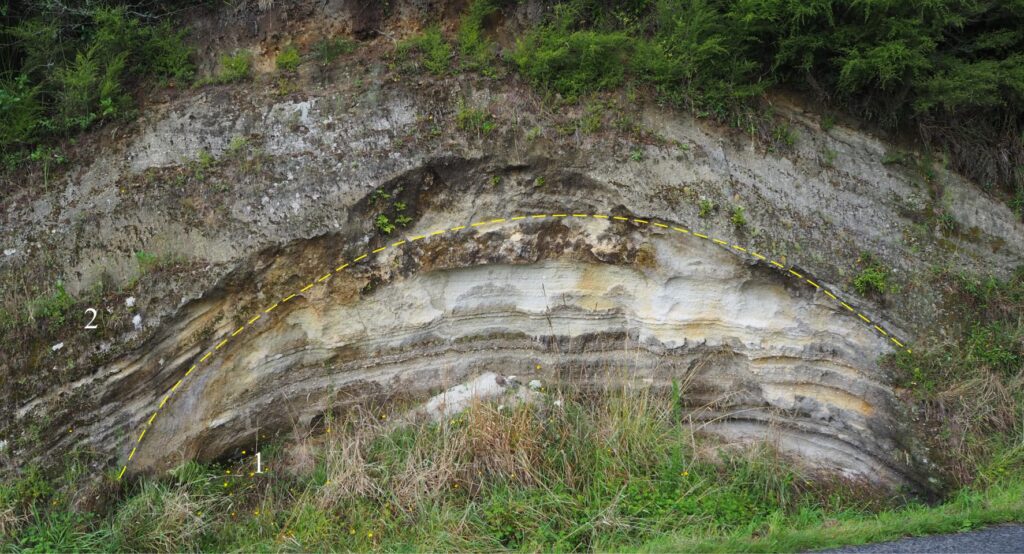
- Deposit thickness and extent depend initially on the eruption intensity (eruption rate), and magnitude (the total volume-mass of lava or its equivalent in terms of fragmental material).
- Airfall deposits are thickest close to the eruption vent, decreasing outwards. Mapped extent is usually presented as an isopach map – isopach contours are commonly elliptical- to fan-shaped with the apex at the vent.
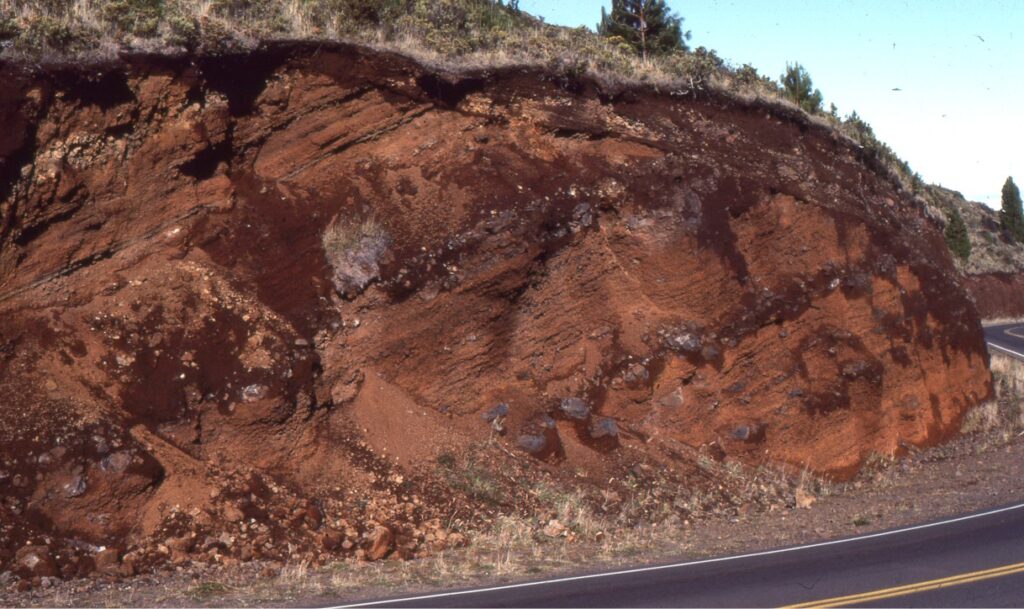
- Grain size generally decreases with increasing distance from the vent.
- Deposit thickness is relatively uniform over topographic highs and lows (unlike pyroclastic density current deposits that tend to thicken in topographic lows). However, factors such as prevailing wind and precipitation during or following deposition can alter this general pattern.
- Airfall deposits from a single eruption pulse tend to be moderately sorted – the result of airborne hydraulic sorting. However, grain size can vary considerably from one tephra layer to the next, depending on eruption severity and longevity. Post-depositional sorting is also possible if there is sufficient wind strength or surface-water runoff to rework the tephra, but to make this distinction there should be some evidence for bedload conditions such as crossbedding or scouring.
- Airfall tephras can be interbedded with deposits derived from other eruption and depositional mechanisms, including those that occur during the same eruptive episode. Common examples include pyroclastic density flows and surges, block-and-ash flows, and lahars.
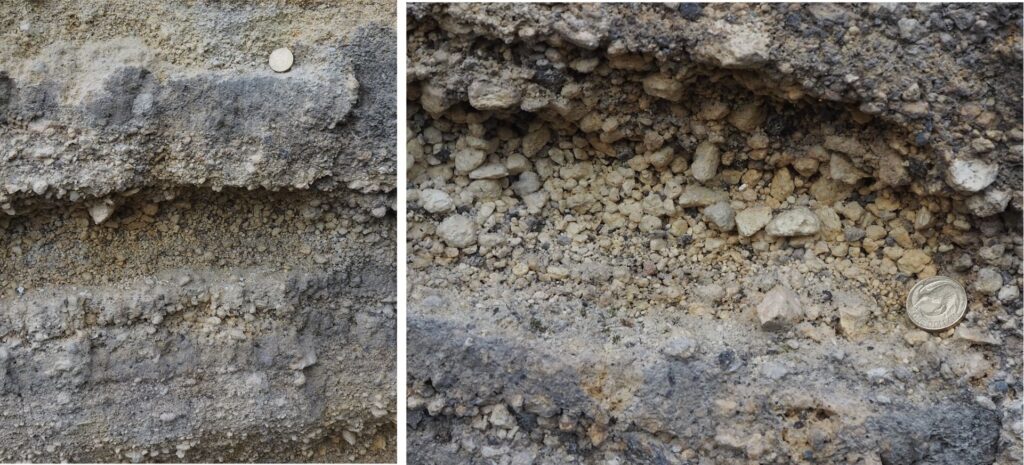
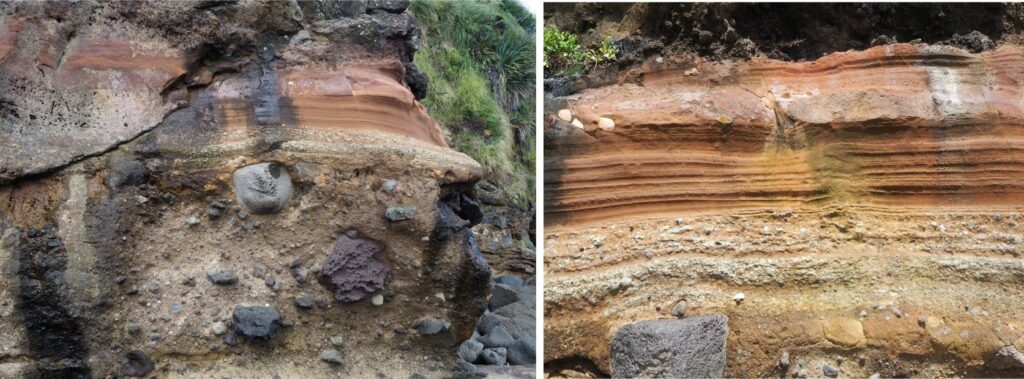
- Aggregates of ash commonly form within eruption columns, promoted by the collisions of electrically charged ash particles and water bonding (vapour phase). Accretionary lapilli are the most easily recognised structures of this kind in airfall tephras
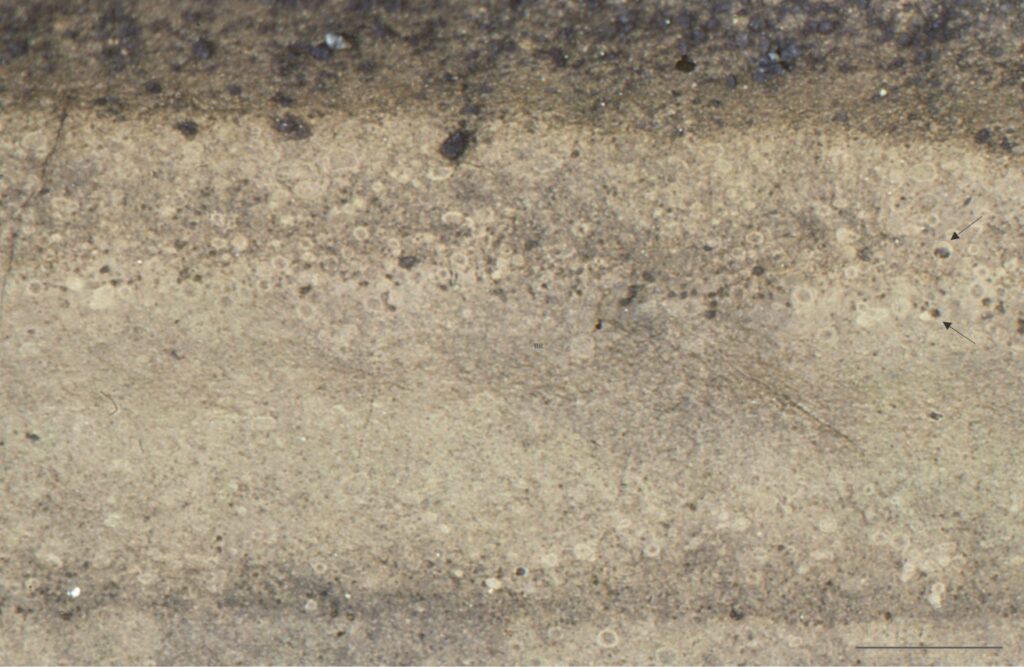
The Tikitapu Lake Road outcrop
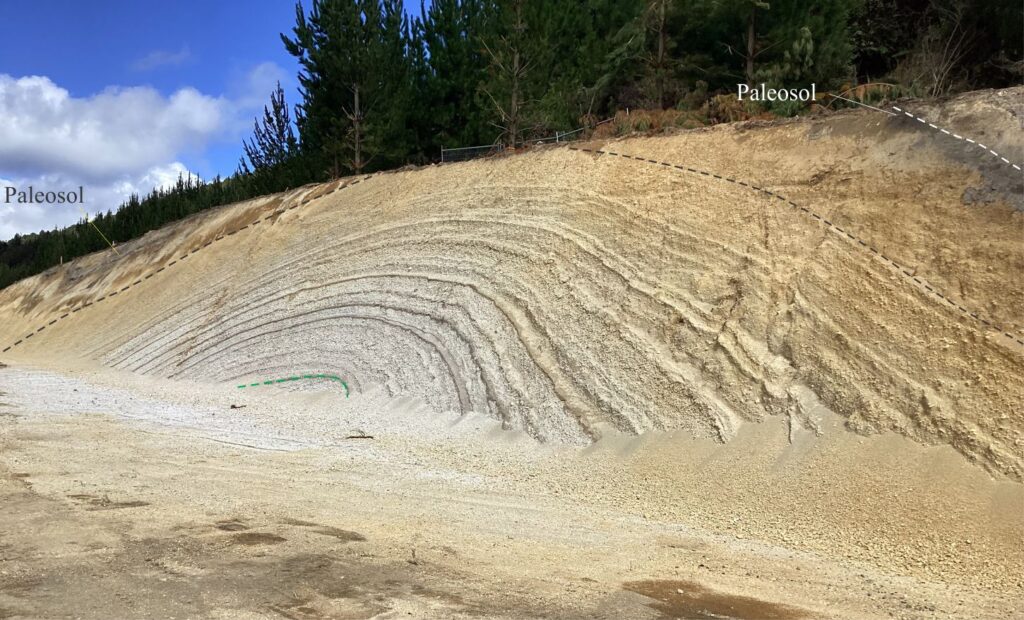
- The exposure is about 45 m long and 6 m high.
- The vertical weathering profile presents a typical upwards transition from fresh, unconsolidated tephra to deposits with increasing proportions of iron oxides and bedding that is less distinct. The unit is capped by at least two paleosols.
- A barely exposed lower unit of layered ash and lapilli is truncated at an erosional discordance (red dashed line). The asymmetry of the discordance represents an element of the local topography that developed during the erosional event.
Subsequent tephra layers draped the antecedent topography, mimicking the asymmetry of the topographic “high” (steepest on the right); the asymmetry decreases upward.
- The geomorphic expression of the modern surface is a lower-relief version of the earlier topographic form. The main tephra unit and paleosols are truncated by this surface.
- Bedding is relatively abrupt and planar between the finer ash layers, but more irregular where lapilli-rich beds are overlain by finer grained ash, contingent on the bed roughness associated with the larger lapilli fragments.
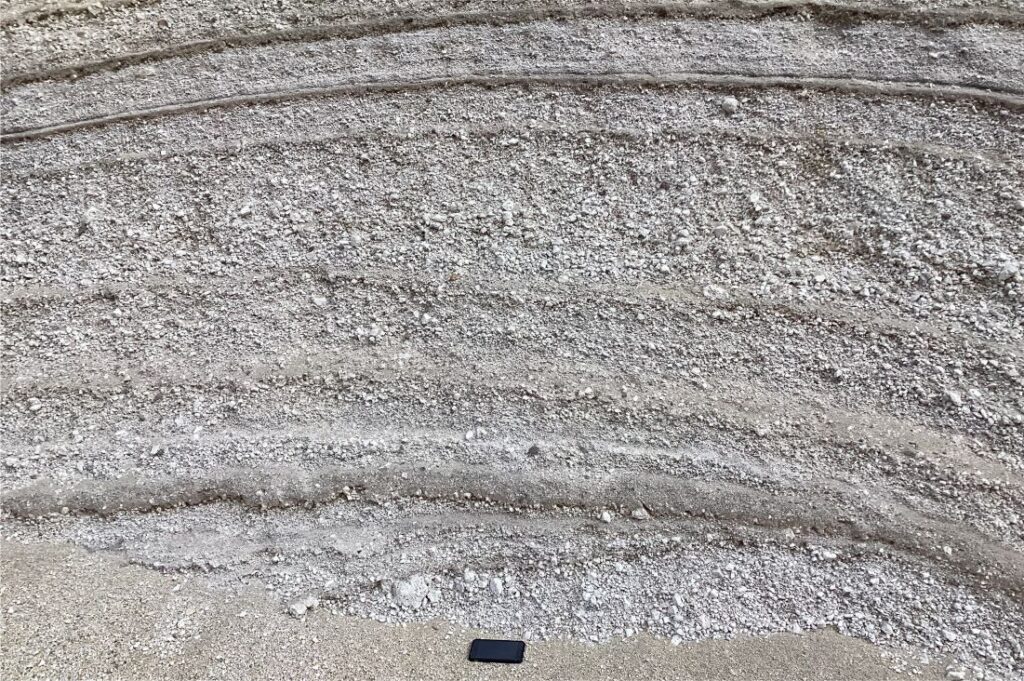
- Tephra layer thickness ranges from 2 to 40 cm. Each layer has a relatively limited range of clast sizes. Layers of ash are shades of brown and grey and are less than 20 cm thick. Layers composed of lapilli are thicker; most clasts are <30 mm, but a few are 60-80 mm across. Several layers thicken slightly over the right flank of topographic high. The deposits are unconsolidated.
- Clasts have predominantly equant dimensions; most are angular.
- The most obvious composition is dense rhyolite, lacking vesicularity.
- There are no obvious sedimentary structures that indicate bedload movement of sediment.
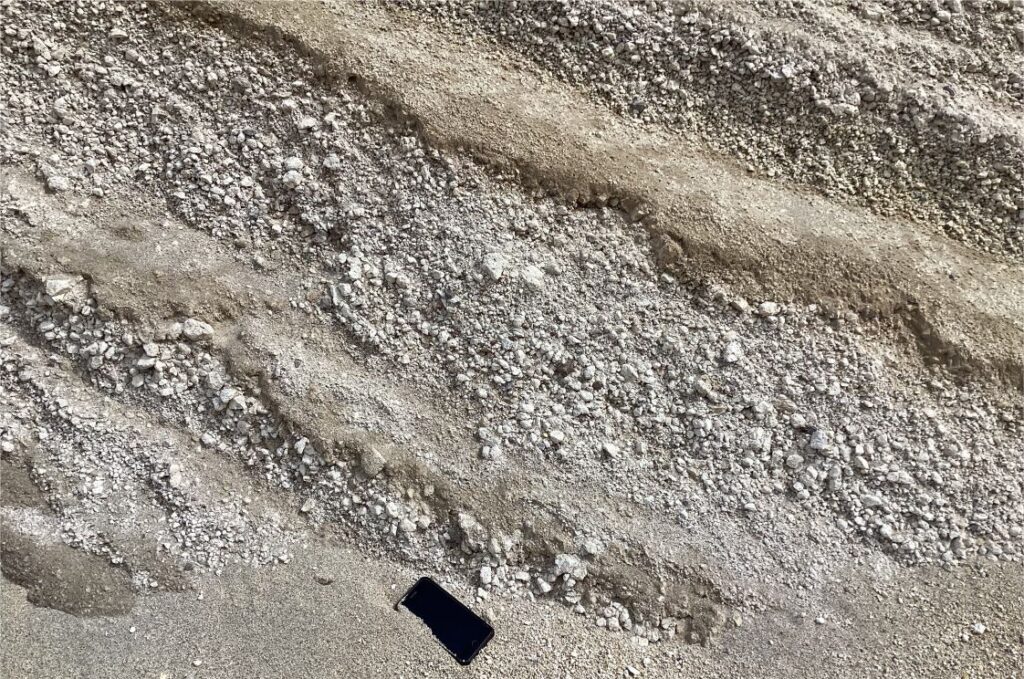
Interpretation
The conformity of the tephra layers, the singular clast composition, and the degree of clast sorting within each layer suggests that the succession was derived from multiple eruption pulses during a single eruption episode from a single vent (duration unknown). The variation in clast size from one bed to the next is primarily a function of the variable intensity of each eruption pulse. It is tempting to interpret the scour-like structures at the base of some beds as indications of precipitation and surface runoff between some eruption pulses, but this is equivocal. The location and age of the eruption episode is not known.
Most eruptions in the OVC produced rhyolite ejecta although a few basaltic eruptions occurred in the Rotoma embayment at the northern extent of the OVC; most eruptions were violent and explosive. Mapping of OVC over the last few decades has identified at least 35 vents that were active during the last 21,000 years, although many large, older eruptions are also known. Two rhyolite domes, mapped close to Lake Tikitapu have ages of 21,000 and 13,500 years, also produced ash and pyroclastic flow deposits. Eight large, explosive eruptions 50,000 to 24,000 years ago produced widespread pyroclastic airfall and flow deposits (I.A. Nairn – OVC Geology). Any of these episodes is a potential candidate for the Tikitapu deposit.
Related posts
Volcanics in outcrop: Lava flows
Volcanics in outcrop: Secondary volcaniclastics
Volcanics in outcrop: Pyroclastic fall deposits
Volcanics in outcrop: Pyroclastic density currents
Ignimbrites in outcrop and thin section
Accretionary aggregates and accretionary lapilli
Class 5; The Toba eruption – how a super volcano almost stopped humanity in its tracks

















